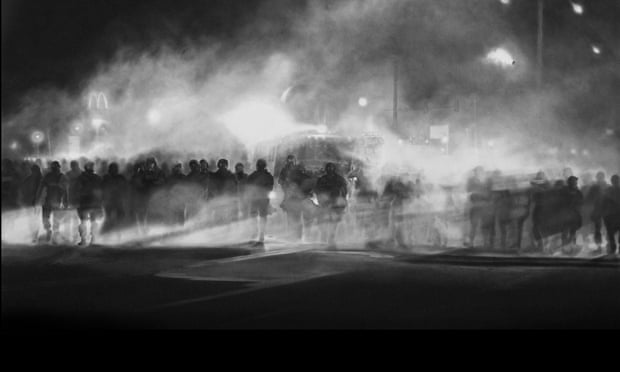Why a charcoal of police in Ferguson is the most important artwork of 2014
Robert Longo’s powerful drawing of police holding back protesters in
Ferguson is a vital record of the resurgence of racism and a history
painting for our time

2014 has produced horrific politics. Racism has returned, that
hydra-headed idiot, everywhere from Missouri to Rochester, where a Ukip
candidate won a byelection after openly speculating about repatriating Europeans. It is not much by way of compensation to say the year also produced a mighty piece of political art. But it did.
Robert Longo’s Untitled (Ferguson Police August 13, 2014) is a 10-ft wide charcoal drawing of a line of faceless cops, clad and helmeted in black, silhouetted against searchlights in a swirl of illuminated smoke. This is a brilliantly powerful drawing, based on photographs taken on the angry streets of Ferguson, Missouri, after 18-year-old Michael Brown was shot dead by a police officer there on 9 August. Since the first protests and police reaction that Longo set out to draw, this has become an ever more significant moment in the old and unending story of racial injustice in America. Longo’s picture looks prophetic and monumental. It should be purchased by the Museum of Modern Art or the National Gallery of Art. This is a true history painting for our time, done from photographs in desolate charcoal.
When an artist takes a photographic image and redraws, repaints or otherwise transforms it, that photograph is lifted out of the remorseless stream of information that bombards us and given heightened significance. The artist, as Marcel Duchamp used to say, has “chosen” it. Andy Warhol made such a choice when he silk-screened a sickening news photograph of a civil rights protester being attacked in Birmingham, Alabama in 1963. Warhol’s 1964 work shows the police setting a dog on a “rioter”.
Fifty years on, the illusion that America has changed since the early 1960s has turned to ash. Longo’s tremendous drawing is ashen, funereal; a shroud for lost optimism. The police in it are demons, hellish, implacable and alien. In fact, rather than Warhol, the photo-based artwork of the 1960s that it recalls is Robert Rauschenberg’s set of illustrations to Dante’s Inferno. At a time of turmoil in America, Rauschenberg silkscreened news photographs of riot cops into his images of Dante’s Hell. The police personify demons in Rauschenberg’s nightmare modern mythology.
In Richard Hamilton’s history painting The State, a photograph of a British soldier on the streets of northern Ireland is transfigured into a monumental image of alienation and fear. The Troubles that Hamilton immortalised in art seem to belong to the past now, mercifully. But this year proved that racism in America is a history still monstrously alive.
Longo’s formidable drawing shows the shadow on America’s conscience. It takes the passing news images of this year and tells future generations which ones really mattered. Like any great historical work of art it insists on the weight of the moment it makes timeless. It is the work of art that mattered most this year.
Robert Longo’s Untitled (Ferguson Police August 13, 2014) is a 10-ft wide charcoal drawing of a line of faceless cops, clad and helmeted in black, silhouetted against searchlights in a swirl of illuminated smoke. This is a brilliantly powerful drawing, based on photographs taken on the angry streets of Ferguson, Missouri, after 18-year-old Michael Brown was shot dead by a police officer there on 9 August. Since the first protests and police reaction that Longo set out to draw, this has become an ever more significant moment in the old and unending story of racial injustice in America. Longo’s picture looks prophetic and monumental. It should be purchased by the Museum of Modern Art or the National Gallery of Art. This is a true history painting for our time, done from photographs in desolate charcoal.
When an artist takes a photographic image and redraws, repaints or otherwise transforms it, that photograph is lifted out of the remorseless stream of information that bombards us and given heightened significance. The artist, as Marcel Duchamp used to say, has “chosen” it. Andy Warhol made such a choice when he silk-screened a sickening news photograph of a civil rights protester being attacked in Birmingham, Alabama in 1963. Warhol’s 1964 work shows the police setting a dog on a “rioter”.
Fifty years on, the illusion that America has changed since the early 1960s has turned to ash. Longo’s tremendous drawing is ashen, funereal; a shroud for lost optimism. The police in it are demons, hellish, implacable and alien. In fact, rather than Warhol, the photo-based artwork of the 1960s that it recalls is Robert Rauschenberg’s set of illustrations to Dante’s Inferno. At a time of turmoil in America, Rauschenberg silkscreened news photographs of riot cops into his images of Dante’s Hell. The police personify demons in Rauschenberg’s nightmare modern mythology.
In Richard Hamilton’s history painting The State, a photograph of a British soldier on the streets of northern Ireland is transfigured into a monumental image of alienation and fear. The Troubles that Hamilton immortalised in art seem to belong to the past now, mercifully. But this year proved that racism in America is a history still monstrously alive.
Longo’s formidable drawing shows the shadow on America’s conscience. It takes the passing news images of this year and tells future generations which ones really mattered. Like any great historical work of art it insists on the weight of the moment it makes timeless. It is the work of art that mattered most this year.
No comments:
Post a Comment